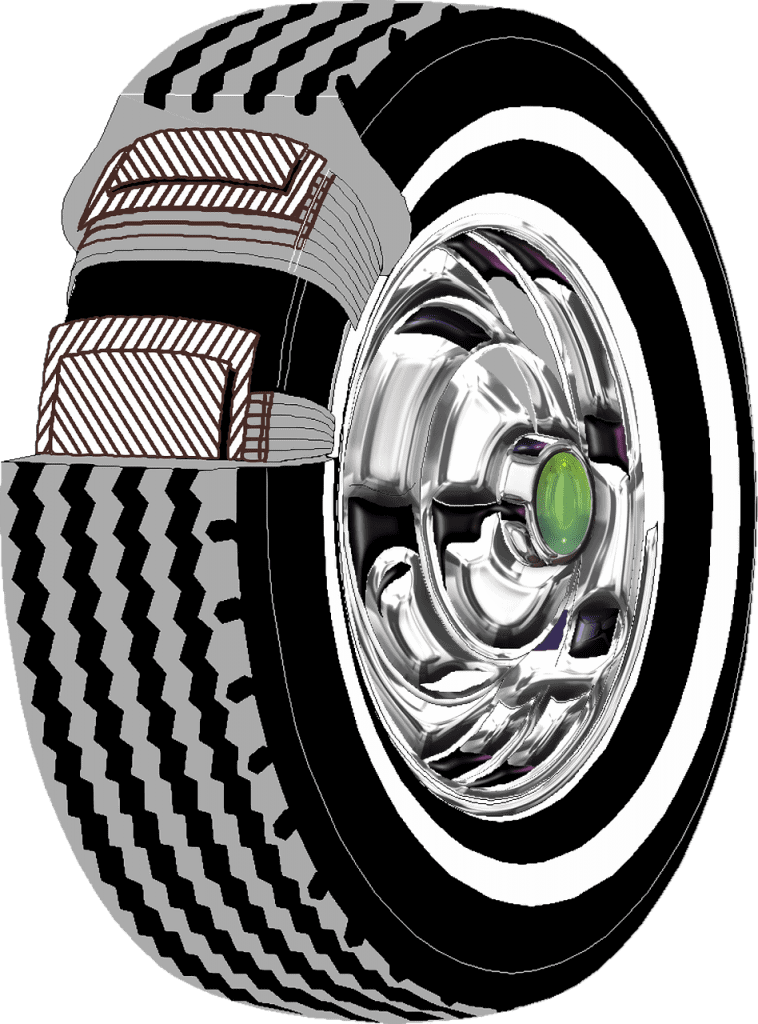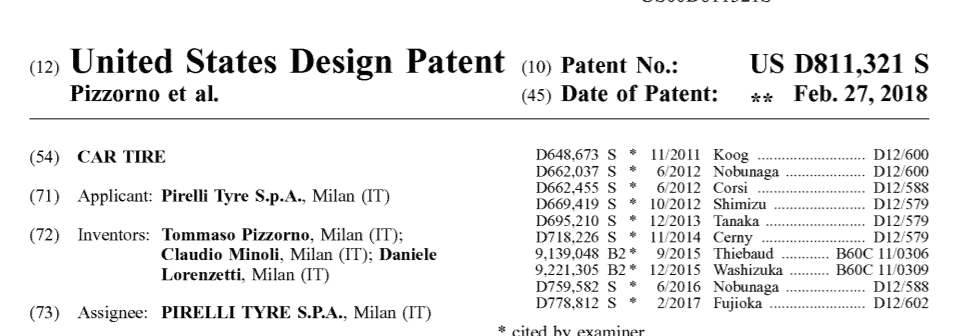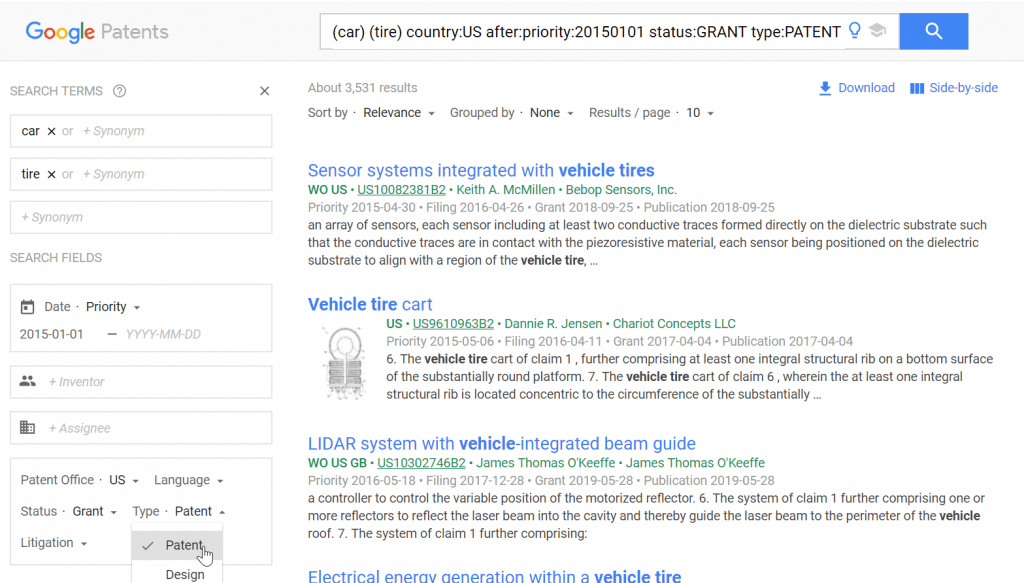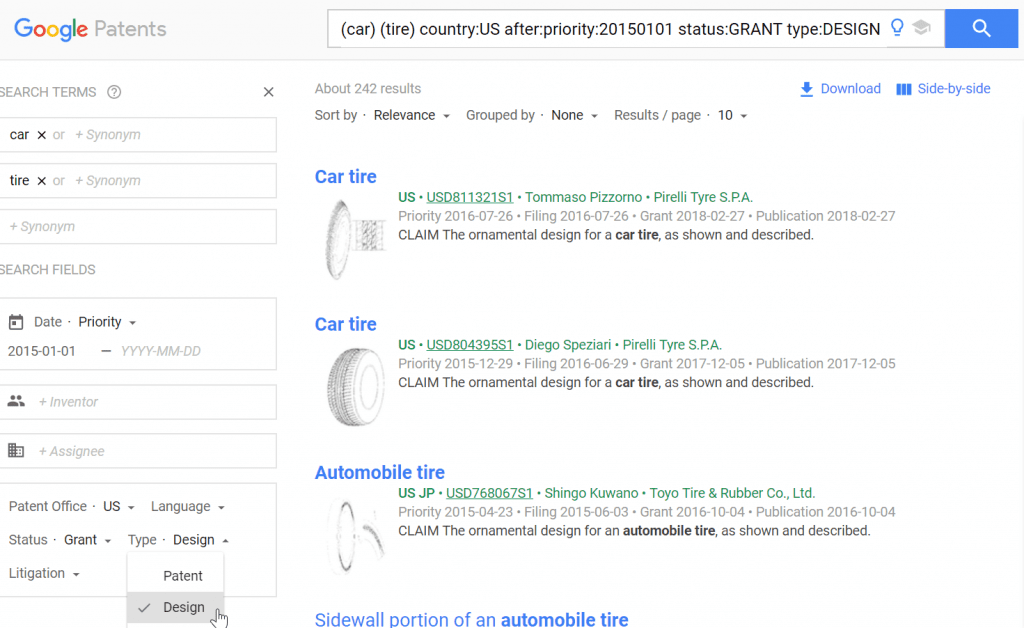Design Patents are the second most common type of patent sought after in the US.
The most common is a Utility Patent, which protects the functionality of an invention.
…Just to throw some numbers out, there have been over 10 Million utility patents granted, and only 1 Million Design patents granted as of the writing of this article.
The least common are Plant Patents, with fewer than 100,000 issued to date.
What is a Design Patent?
Design patents protect articles of manufacture (things you can actually build/create in 3D) and cover only the ornamentation, or the way it looks.
How do you tell the difference between a utility, design, or plant patent? Well, as you’re browsing on the USPTO website or on Google Patents, take a look at the upper right corner.
Here are the differences, highlighted by using a novel tire technology:

- Utility Patent – you can tell by the simple label “US 10,082,381”, as shown below:

- Design Patent – You can tell because of the “D” in “US D811,321 S”

- Plant Patent – You can tell because of the “PP” in “US PP28,613”

Here is how I searched:
- This is how I queried for the UTILITY patent in Google Patent Search. Notice how I select “Patent” under the type of patent document

- Below is the same search query, but I select “Design” instead of “Patent” in order to get the Design Patents with the same query of “car tire”:

For the plant patent, I had to type in a new query… there were no results for “car tire” for a plant patent (which would have been odd, to be fair).
Ok, so you are now understanding the basics of how to tell what type of patent document you’re looking at whether it be a design, utility, or plant patent.
….However, the real question should be…
What type of patent should you seek for your invention?
THIS is the real question and is one that shouldn’t be decided by you, but by a trained legal advisor. In many cases, your invention may have both functional and design aspects that are unique, and therefore both utility and design protection should be sought.
Here is a full guide on the differences between design and utility patents
In any case, the decision on which type of patent protection to seek will be best made AFTER doing the research and diligence to confirm the novelty of the invention prior to filing.

Why Do a Patent Search?
A patent search will inform a Patent Attorney of certain prior art that will aid them in making a determination of patentability, giving you, the inventor the best information to make a business decision about whether an investment in a patent is a prudent course of action.
Was that too dry? Haha. Here it is again in simpler terms…
The Bottom Line: A good patent search and legal opinion will help you determine whether you should file a patent or not…and THAT could save you tens of thousands.
DO NOT cut corners on the research, as it will always come back to bite you later.
As you (hopefully) saw in the above article on the differences between design and utility patents, design patents protect the aesthetic or ornamental quality of a three-dimensional object. The key is that the protection extends only so far as the shape, and NOT to functionality.
Here are some other MAJOR reasons why you want to do a design patent search:
Deadline to File:
- You need to consider the fact that if you’ve publicly disclosed your invention (taken to tradeshow, sold or offered for sale, presented it, put it up on Kickstarter, etc.) then you only have 12 months for a utility filing and only 6 months for a design filing before IT BELONGS TO THE PUBLIC DOMAIN.
- The last thing you want to do is file a poorly written patent application, so you MUST conduct a patent search first. So don’t delay, as you must do the search and the application before 6 months is up from the earliest publication.
Patent Application Rejected By Examiner:
- Without doing a search before you file, an obvious prior art (or previous patent/publication) could be out there and you’ve wasted your time and money filing for a patent to just get solidly rejected.
- Rejections are actually very common, even for well researched and well-written patent applications – but to get an obvious one that would have been found by a simple Google search is embarrassing and a great reason to spend the time up front to do the diligence.
How do you conduct a Design Patent Search?
You simply turn the shape into words!
Then search on functional language and terms just like you do for utility patents.
So, for a potentially unique design, you want to start brainstorming for potential ways in which the design could be useful and think as laterally as possible in terms of the use cases, applications, industries, and implementations.
Mobile Phone Case Design Example
Let’s use an example to illustrate. How about something that almost all of us have in our pockets…a mobile phone!

Now the actual phone aside, we’re going to focus on the phone case. It is important to note that what is being protected, even if the title of your unique case design is “phone case”, is a three-dimensional work of art. If built, it would provide the proportions and elements necessary to protect a phone, but is silent as to material, strength, and dimension.
In the image above, there are the following elements about the case that stand out:
- Rectangular in shape
- Chamfered (or rounded) corners
- Chamfered (or rounded) edges
- Low profile (meaning the thickness is much smaller than the width and height)
- Has a hole/penetration on one of the ends of the case
- Has a cavity (which we can’t see in the one image)
- Has a smooth surface
We could go on, but for our purposes, let’s use these for starters.
Brainstorm!!!

So with each of these DESIGN aspects, create an expansive (imaginative…inventive even) list of FUNCTIONAL terms for which we will form the basis of our natural language searching.
- Rectangular
- Fits in hand
- Ergonomic
- Pocket-sized
- Geometric/Polygonal
- …..think how this shape could be used in other industries or has relationships with an ear to a mouth, why a square or a circle might not work….
- Chamfered
- Safe (no sharp edges)
- Ergonomic
- Simple, no moving parts
- For docking/storage
- …think how this shape conforms not just to the user’s hand but the PHONE, and how it might be a minimization of materials for lightweight functionality
- Low profile
- Portability
- Space saver
- Fits with other items in bag/backpack
- Not heavy(?)
- Has a Hole on End
- For camera/sensors
- For cables
- Attachments/Locks
- Vacuum seal
- Needs a cover/cap?
- ….let your creativity fly here
- Has a Large Cavity to Accept Phone
- Friction fit
- No fasteners
- High fatigue materials
- Flexible Material
- Smooth Surface
- Slippery?
- Easy Interface with other objects
Ok! So, I think you get the idea, have fun with this! The goal is to really expand what you SEE in design to put terms that could help develop into key phrases that can be searched using USPTO, Google Patents, just like we do for utility patent applications.
KEYNOTE: Utility patents will come up in the searches, and what’s important to know is that utility patent drawings WILL ACT AS PRIOR ART TO REJECT YOUR DESIGN PATENT APPLICATION.
So, it’s imperative that we do our search not just keeping the design/shape/aesthetic in mind, but also the utility.
In Summary
As you can read further in How to do a Patent Search in 6 Steps, the next steps are:
- Understanding What a Patent Search Is
- Invention Disclosure
- Identify 3-5 Key Features/Words
- Conduct a Broad Search (Google)
- Identify Classifications
- Conduct Focused Search (Non-Google)
To see what’s involved in each of those steps, simply click the link above!
To wrap up, you may still be asking questions about design patents, and that’s good. Please be sure to read the full article I wrote on design patents, How to File a Design Patent Application in 10 Steps, it will help you fully appreciate the nuances and when to have a consultation with a patent attorney about protecting your next invention.
Are you ready to start your design patent journey?
Legal Note: This blog article does not constitute as legal advice. Although the article was written by a licensed USPTO patent attorney there are many factors and complexities that come into patenting an idea. We recommend you consult a lawyer if you want legal advice for your particular situation. No attorney-client or confidential relationship exists by simply reading and applying the steps stated in this blog article.

